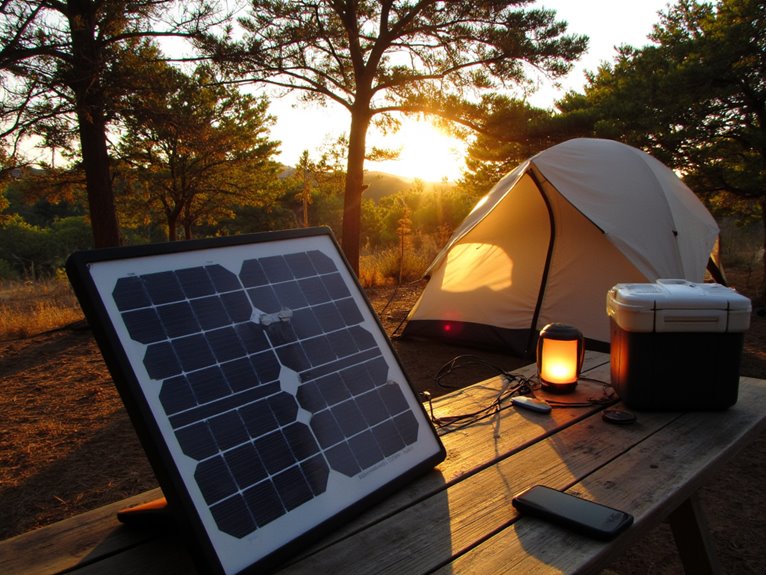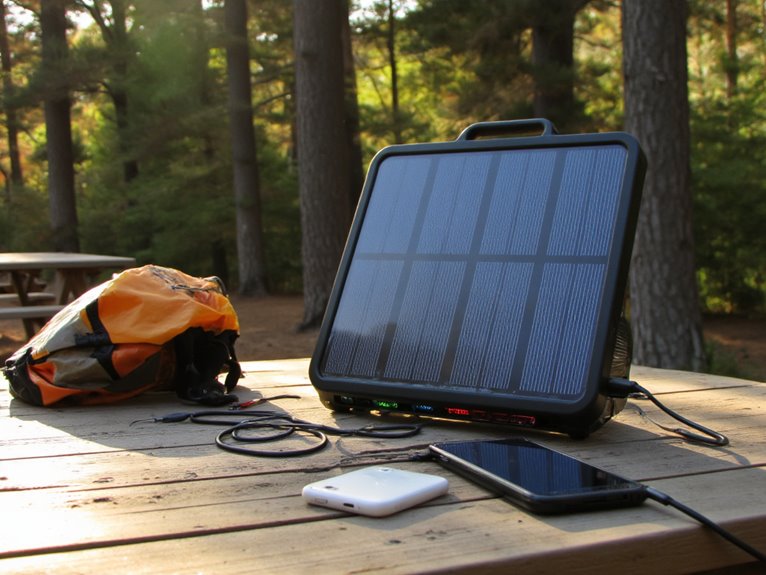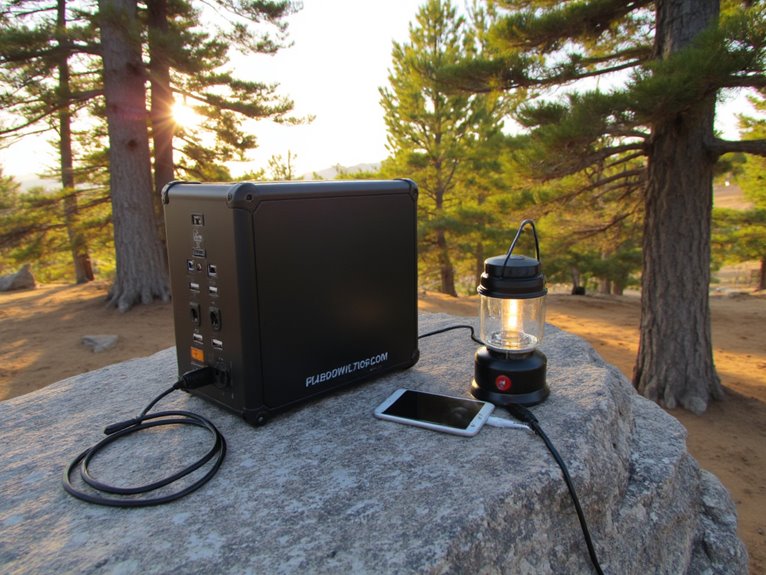The Essential Guide to Solar Power Stations for Camping
You’ll need to calculate your daily power consumption by listing devices and multiplying their wattage by runtime hours, then select a solar power station with 20-30% extra capacity as buffer. For overnight trips, 100-200Wh suffices, while week-long excursions require 1000+Wh with LiFePO4 batteries. Position panels 10-15 feet from shadows and adjust angles seasonally-latitude plus 15° in winter, minus 15° in summer. MPPT charge controllers optimize efficiency, while pure sine wave inverters safely power sensitive electronics. Proper setup and maintenance strategies reveal solar camping’s full potential.
We are supported by our audience. When you purchase through links on our site, we may earn an affiliate commission, at no extra cost for you. Learn more. Last update on 7th January 2026 / Images from Amazon Product Advertising API.
Notable Insights
- Solar panels convert sunlight to DC electricity, stored in LiFePO4 batteries and converted to AC power via inverters.
- Calculate daily power needs by multiplying device wattage by runtime hours, then add 20% buffer for efficiency losses.
- Battery capacity requirements range from 100-200 Wh for overnight trips to 1000+ Wh for week-long camping excursions.
- Position panels 10-15 feet from large objects and track sun movement to maximize energy collection by 25-40%.
- Perform monthly battery checks, weekly panel cleaning, and pre-trip wiring inspections for optimal performance and longevity.
Understanding Solar Power Station Components and Technology
When you’re selecting a solar power station for camping, understanding its core components guarantees you’ll make an informed decision that matches your outdoor power needs.
Solar panel types utilize photovoltaic cells made from semiconductor materials like silicon. These panels capture sunlight and initiate energy conversion through the photovoltaic effect, producing direct current electricity.
Solar panels harness sunlight through silicon photovoltaic cells, converting solar energy into usable direct current electricity via the photovoltaic effect.
Your power station stores this energy in LiFePO4 batteries, measured in watt-hours. A pure sine wave inverter converts stored DC power into AC electricity compatible with your devices. MPPT charge controllers optimize charging efficiency by dynamically adjusting voltage and current.
Built-in safety features protect against overcharging, overheating, and short circuits. Multiple outlet types-USB-A, USB-C, AC, and 12V DC-provide simultaneous charging flexibility for various camping equipment.
Modern camping requires expandable ecosystem solutions that can grow with your power demands as you add more devices and extend your outdoor adventures. These systems eliminate the need for noisy generators while providing reliable power in remote outdoor settings.
Calculating Your Camping Power Requirements

Before purchasing a solar power station, you’ll need to calculate your exact energy requirements to avoid buying insufficient or oversized equipment.
Start by inventorying every electronic device you plan to use during camping, then multiply each device’s wattage by its expected daily runtime hours to determine your total daily watt-hour consumption. Consider using a Van Electrical Calculator to simplify this process and ensure accurate component sizing for your specific needs.
This calculation forms the foundation for selecting appropriate battery capacity and solar panel output that matches your specific power demands. Remember to account for surge watts when appliances start up, which typically require 1-2 times their normal running wattage.
Essential Device Power Needs
Calculating your camping power requirements starts with creating a thorough inventory of every electronic device you’ll bring on your trip.
List each device with its specific wattage or amperage ratings found on manufacturer labels or user manuals. Small electronics like smartphones typically consume 5-15 watts, while tablets draw 10-25 watts during charging.
Essential device compatibility becomes critical when matching power station ports to your equipment’s input requirements.
Power consumption trends show camping refrigerators demand 50-100 watts continuously, making them significant power drains. LED lights use 5-15 watts, portable fans consume 15-50 watts, and CPAP machines require 40-60 watts.
Calculate total daily consumption by multiplying each device’s wattage by expected usage hours. Add 20% buffer capacity for efficiency losses and unexpected usage increases.
Daily Energy Consumption Calculation
The next step in calculating your camping power requirements involves determining your total daily energy consumption measured in watt-hours (Wh).
Multiply each appliance’s wattage by its daily usage hours. For devices used in minutes, divide watts times minutes by 60. A 20W fan running 4 hours consumes 80 Wh daily.
Energy monitoring becomes essential for appliances with cyclical operation like refrigerators. A fridge rated at 80W maximum typically runs one-third of the time, averaging 27W or 648 Wh daily.
Your usage patterns greatly impact calculations. Convert total consumption to amp hours using the formula: Current = Power ÷ Voltage.
Sum all individual device consumption for total daily requirements. Account for surge wattage during startup for motors and compressors when sizing your solar power station.
Battery Capacity Requirements
Once you’ve calculated your daily energy consumption, selecting appropriate battery capacity becomes your next critical decision.
Battery sizing depends on your trip duration and total power draw requirements.
Here’s how to determine your capacity needs:
- 100-200 Wh – Basic overnight trips with minimal devices (phones, LED lights only)
- 200-500 Wh – 1-2 nights with moderate usage (laptops, tablets, speakers, lighting)
- 500-1000 Wh – Multi-day excursions including cameras, drones, small coolers
- 1000+ Wh – Week-long adventures with extensive device support
Calculate by multiplying your daily consumption by trip length, then add 20-30% for efficiency losses.
Family weekend trips typically require 500-800 Wh capacity to handle approximately 810 Wh daily consumption.
Consider both continuous power draw and peak amperage requirements when finalizing your selection.
Selecting the Right Solar Power Station for Your Needs
How do you determine which solar power station will meet your specific camping needs without overspending or underperforming?
Start by matching your calculated watt-hour requirements to available power station types. Portable 100 Wh units suit lightweight backpacking, while heavy-duty 3,600 Wh generators handle extended car camping or RV setups.
Match your power needs to station capacity: 100 Wh for backpacking, 3,600 Wh for car camping and RV adventures.
Verify that output ports match your devices-USB, AC outlets, and 12V DC connections. Consider charging options beyond solar panels, including AC outlets and car chargers for cloudy conditions.
Weather-resistant models perform better in harsh environments. Balance capacity with portability; heavier stations up to 99 pounds work for car camping, but backpackers need compact alternatives.
Compare bundled kits versus separate components for best value and compatibility.
Optimal Solar Panel Positioning and Setup Strategies
Getting maximum power from your solar panels requires strategic positioning that accounts for three critical factors.
You’ll need to optimize sunlight exposure by placing panels where they receive direct solar radiation for the longest duration possible throughout the day.
Proper angle adjustment and careful avoidance of shadow obstacles can increase your energy output by 25-40% compared to poorly positioned panels.
Maximizing Sunlight Exposure
When camping with solar power systems, proper panel positioning determines the difference between adequate electricity and disappointing performance throughout your trip.
Effective sun path tracking and shadow analysis form the foundation of ideal energy collection at any campsite.
Here are four critical strategies for maximizing solar exposure:
- Conduct pre-setup solar access assessments using sun tracking apps to map potential shadowing throughout the day.
- Position panels away from morning and afternoon shadow zones where low sun angles create extended blocked periods.
- Deploy portable panels with extended cables to reach ideal sunny locations independent of equipment placement.
- Monitor dynamic shadows from moving branches and clouds that can reduce output by 50% or more.
Repositionable mounting systems allow you to track sun movement, while multiple smaller panels distributed across sunny spots often outperform single large installations in variable conditions.
Angle Adjustment Techniques
Beyond proper positioning, ideal panel angles can increase your solar collection efficiency by 25-40% compared to flat installations.
Seasonal optimization requires different tilt calculations throughout the year. In winter, set your angle to latitude plus 15° to capture low-trajectory sunlight. Summer positioning works best at latitude minus 15° for higher sun paths.
The refined calculation method uses latitude × 0.9 + 29° for winter and latitude × 0.9 − 23.5° for summer.
Adjustable mounting systems enable quick angle adjustment between 0° and 60° tilt ranges.
Use smartphone apps or solar calculators to determine precise angles for your location.
Spring and fall positions should equal latitude minus 2.5°. Secure locking mechanisms prevent wind displacement while maintaining your optimized angle throughout the day.
Avoiding Shadow Obstacles
Shadow interference can reduce your solar panel output by 80% or more, making obstacle avoidance critical for maintaining power generation during camping trips.
Dynamic shading from trees, vehicles, and camping equipment creates constant positioning challenges that require proactive shadow monitoring throughout the day.
Strategic placement eliminates most shadow-related power losses:
- Position panels 10-15 feet from large objects like trees or vehicles to prevent moving shadows from reaching your panels during peak sun hours.
- Use solar path tracking apps such as Sun Seeker to predict shadow patterns and identify ideal positioning zones before setup.
- Monitor tent poles and awnings that create intermittent shading as sun angles change throughout the day.
- Implement flexible cable systems allowing quick panel relocation when unexpected shadows appear from nearby campers or equipment.
Maximizing Energy Efficiency During Outdoor Adventures
While solar power stations offer excellent renewable energy solutions for camping, you’ll achieve peak performance only through precise energy management and efficient system design. Calculate your total energy consumption using the formula kWh = (watts × hours) ÷ 1000. Include surge requirements, typically 1-2 times running wattage for startup power. Energy efficient appliances greatly reduce your system’s load requirements.
| Device Type | Running Watts | Surge Watts | Daily Hours | kWh Usage |
|---|---|---|---|---|
| LED Lights | 10 | 12 | 6 | 0.06 |
| Phone Charger | 15 | 18 | 2 | 0.03 |
| Laptop | 65 | 130 | 4 | 0.26 |
| Mini Fridge | 45 | 135 | 12 | 0.54 |
| Fan | 35 | 105 | 8 | 0.28 |
Solar power advantages include unlimited renewable energy and silent operation. Monitor battery capacity regularly and schedule heavy consumption during peak solar generation hours for ideal efficiency.
Best Practices for Maintenance and Performance

Proper maintenance transforms your solar power station from a simple camping accessory into a reliable, long-term energy solution that’ll serve you for years of outdoor adventures.
Essential Maintenance Protocols:
- Battery Maintenance Schedule – Check batteries monthly for corrosion and physical damage. Store at 50% charge during extended periods and recharge every three months to maintain ideal capacity.
- Cleaning Procedures Protocol – Clean solar panels weekly using soft cloths and soapy water. Remove debris that blocks sunlight and inspect for cracks or scratches that reduce efficiency.
- Component Inspection Routine – Test all wiring connections, ports, and adapters before each trip. Look for fraying, loosening, or corrosion that causes power loss.
- Storage Environment Control – Keep equipment in cool, dry locations using protective cases. Detach cables during long-term storage to prevent connection wear.
Units with LiFePO4 batteries typically offer over 3500 charge cycles when properly maintained, making them exceptionally durable for long-term camping use.
Environmental Impact and Sustainable Camping Benefits
Beyond maintaining your solar equipment’s peak performance, these systems deliver measurable environmental benefits that transform how we approach outdoor recreation.
Solar energy eliminates camping emissions from fuel-based generators, reducing harmful pollutants by up to 100%. You’ll contribute to wildlife protection by operating noise-free equipment that won’t disturb natural habitats. This green technology supports pollution reduction through zero-emission electricity generation over 25-30 year lifespans.
Your investment in eco friendly infrastructure enables campgrounds to redirect energy savings toward conservation initiatives.
Solar power stations eliminate fuel spills and chemical contamination that threaten water sources and soil quality. You’ll maintain natural night skies while powering essential devices.
These sustainable practices demonstrate how modern camping can preserve biodiversity while meeting recreational needs through renewable energy solutions.
On a final note
You’ve now mastered the fundamentals of solar power station technology for camping applications. Your understanding of wattage calculations, battery chemistry, and panel positioning will guarantee peak performance in outdoor environments. You’ll maximize energy efficiency through proper load management and maintenance protocols. Your investment in solar technology reduces environmental impact while providing reliable off-grid power. You’re equipped to select, operate, and maintain systems that’ll enhance your camping experiences sustainably.

